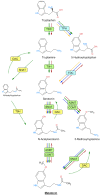Melatonin from Microorganisms, Algae, and Plants as Possible Alternatives to Synthetic Melatonin
- PMID: 36676997
- PMCID: PMC9862825
- DOI: 10.3390/metabo13010072
Melatonin from Microorganisms, Algae, and Plants as Possible Alternatives to Synthetic Melatonin
Abstract
Melatonin dietary supplements are widely consumed worldwide, with developed countries as the largest consumers, with an estimated annual growth rate of approximately 10% until 2027, mainly in developing countries. The wide use of melatonin against sleep disorders and particular problems, such as jet lag, has been added to other applications, such as anti-aging, anti-stress, immune system activation, anticancer, and others, which have triggered its use, normally without a prescription. The chemical industry currently covers 100% of the needs of the melatonin market. Motivated by sectors with more natural consumption habits, a few years ago, the possibility of obtaining melatonin from plants, called phytomelatonin, arose. More recently, the pharmaceutical industry has developed genetically modified microorganisms whose ability to produce biological melatonin in bioreactors has been enhanced. This paper reviews the aspects of the chemical and biological synthesis of melatonin for human consumption, mainly as dietary supplements. The pros and cons of obtaining melatonin from microorganisms and phytomelatonin from plants and algae are analyzed, as well as the advantages of natural melatonin, avoiding unwanted chemical by-products from the chemical synthesis of melatonin. Finally, the economic and quality aspects of these new products, some of which are already marketed, are analyzed.
Keywords: GMOs; dietary supplements; melatonin; microorganisms; phytomelatonin; plant raw material.
Conflict of interest statement
The authors declare no conflict of interest.
Figures



References
-
- Mordor Intelligence Melatonin Market—Growth, Trends, COVID-19 Impact, and Forecasts (2022–2027) [(accessed on 30 October 2022)]. Available online: https://www.mordorintelligence.com/industry-reports/melatonin-market.
-
- Market Analysis Report Melatonin Market Size, Share & Trends Analysis Report By Application, Regional Outlook, Competitive Strategies, and Segment Forecasts, 2019 to 2025. [(accessed on 30 October 2022)]. Available online: https://www.grandviewresearch.com/industry-analysis/melatonin-market.
Publication types
LinkOut - more resources
Full Text Sources
Miscellaneous

